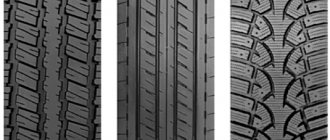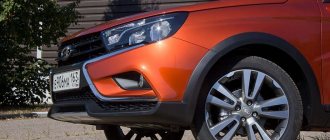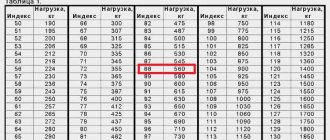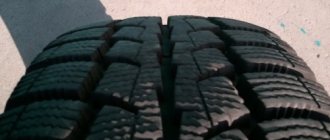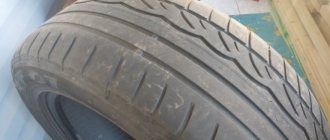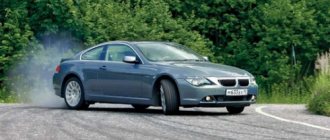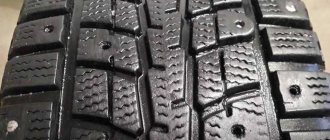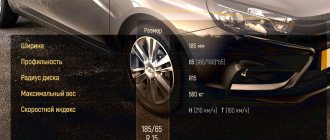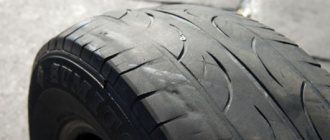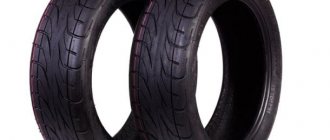Good afternoon, dear reader.
Every year, as cold weather approaches, drivers begin to wonder when to put on winter tires. Currently, the answer to this question is partially regulated by a regulatory legal document.
The relevant law is Technical Regulations of the Customs Union TR CU 018/2011 On the safety of wheeled vehicles.
In this article we will talk about the legally established deadlines for changing summer tires to winter ones. In addition, a fine for improper use of tires will be considered.
Let's get started.
How to store wheels?
Tires should be kept in a cool, dark, dry, ventilated area, avoiding contact with gasoline and oil.
It is better to hang the assembled wheels by the rims or stack them horizontally on top of each other, having previously lowered them to 1 atm. Tires without rims have a place on the rack. Place them vertically side by side.
Proper storage will help your tires stay in shape until next season.
This is how tires removed from rims should be stored vertically. We hang the tires on the rims or stack them on top of each other.
This is how tires removed from rims should be stored vertically. We hang the tires on the rims or stack them on top of each other.
Penalty for improper use of tires in 2021
In 2022, Chapter 12 of the Code of Administrative Offenses does not contain references to the Technical Regulations of the Customs Union. Those. A fine cannot be imposed for not having winter tires.
However, a draft of such a fine exists.
However, there is a fine for using worn winter tires - 500 rubles (or a warning).
This fine can be imposed on a driver using winter tires (marked M+S, etc.) whose tread depth at the most worn place is less than 4 mm. Please note that a fine is imposed only when operating a vehicle on an icy or snowy road surface.
Let's summarize this article:
- By law, you can change tires to winter ones from September to November.
- In practice, the choice of a specific date for replacement must be made taking into account weather conditions. However, I do not recommend changing tires later than November 15th - the unofficial day to change summer tires.
- There will be no penalty for using summer or all-season tires during the winter months in 2022.
Scheme for rearranging wheels when changing shoes
It is better to swap tires when changing shoes.
Here is a diagram for different cars and tire types. It is better to swap tires when changing shoes. Here is a diagram for different cars and tire types.
Pay attention to the correct installation of directional and asymmetrical tires. Check that all bolts (nuts) are screwed and tightened.
To avoid uneven tire wear and deterioration in vehicle performance, at least once a month (or better yet, every two weeks), set the recommended tire pressure to “cold”, since they heat up while driving, which distorts the measurement results.
It helps the spikes finally “settle” in their places - you need to ride smoothly for the first thousand kilometers. And the friction clutches need to get rid of the “crust” on the tread surface and the lubricant between the lamellas. Therefore, the Velcro needs to be tested more actively.
Aggressive driving (especially on asphalt) quickly wears out the tread, and also causes excessive movement of the studs and even “turns” them out of the holes. This leads to premature loss of grip on slippery surfaces.
Photo: depositphotos.com, Michelin, from open sources
- How to break in Velcro tires? 3 tips from Driving experts
- How long can you drive on a flat tire? Unexpected answer from the tester
When is it legal to switch to winter tires?
Let's consider paragraph 5.5 of Appendix 8 to the technical regulations of the customs union TR CU 018/2011 “On the safety of wheeled vehicles”:
5.5. It is prohibited to operate vehicles equipped with tires with anti-skid studs in the summer (June, July, August).
During the winter period (December, January, February), the operation of vehicles of categories M1 and N1 that are not equipped with winter tires that meet the requirements of paragraph 5.6.3 of this annex is prohibited. Winter tires are installed on all wheels of these vehicles.
A period different from that specified in paragraph one of this paragraph may be established by the legislation of a member state of the Eurasian Economic Union in connection with climatic and geographical factors characteristic of member states of the Eurasian Economic Union.
So, what can be understood from this paragraph:
- During the summer months (June, July, August) only studded tires are prohibited. This requirement applies to all vehicles.
- During the winter months (December, January, February), only winter tires are permitted. You can put both studded and non-studded tires on your car. The main thing is that they are marked “M+S”, “M&S” or “MS” and the corresponding drawing (in the picture on the left). The requirement applies only to category B (M1 cars and N1 trucks). The restriction does not apply to other vehicles from November 11, 2022.
- The terms of the ban on exploitation can only be increased by the legislative authority of any level (federal, regional) and cannot be reduced. Those. In your region, for example, the use of studded tires may be prohibited from May to September. At the same time, regional authorities cannot reduce the period of the ban, i.e. From June to August, cars in all regions must not use studs.
Thus, there are the following intervals for using car tires:
- Summer tires (without M+S marking, etc.) can be used from March to November.
- Winter studded tires (marked M+S, etc.) can be used from September to May.
- Winter studless tires (marked M+S, etc.) can be used all year round.
Let's look at a table with periods of possible tire use throughout the year:
| Summer | Winter studded | Winter studless | |
| Winter (December - February) | + | + | |
| Spring (March - May) | + | + | + |
| Summer (June - August) | + | + | |
| Autumn (September - November) | + | + | + |
Thus, if you have summer tires (without markings) and winter studded tires, then you must replace them during the fall, i.e. from September to November.
The tire replacement should be done during the spring, i.e. from March to May.
Riding on Velcro during the summer months of the year
Among motorists, “Velcro” (friction tires) are winter tires that are not equipped with studs.
In accordance with Technical Regulations TR CU 018/2011, you can drive on such tires all year round. After all, tires with studs are prohibited in summer, but Velcro does not have them. Just as you can drive in winter, because it is winter and has the appropriate markings (MS, M & S, M + S).
However, like all-season tires, Velcro tires are highly not recommended for use in the hot season, primarily due to the “softness” of the rubber compound used in their manufacture. Otherwise, the following consequences are possible:
- loss of controllability;
- increase in braking distance;
- acceleration of tire wear;
- increased fuel consumption.
Nuances
- if you come for a technical inspection on winter studded tires in the summer, then nothing will happen (since Appendix 1 to Resolution No. 1008 does not indicate that tires are checked for their compliance with the season);
- It is unclear for how long it is allowed to put a “spare” on (it seems that only for the purpose of traveling to a place of permanent parking and/or repair);
- There was still a draft law on fines for using out-of-season tires (No. 464241-6), but it was never adopted (according to it, it was proposed to add a new part 3.2 to Article 12.5, according to which motorists would be fined 2000 rubles for violating the rules for using wheels and tires).
Source
Car tires: which ones to choose
Experienced drivers recommend the need to have three sets of tires at once: winter, summer and studded.
In the cold season, the air temperature usually ranges from -3°C to +5°C, in this case it is necessary to use winter tires without studs, and when the cold weather comes sharply, it is worth changing to winter studded tires.
- But this method is quite expensive, so it is not accessible to everyone. In this case, you need to choose studded tires or tires without studs.
- Don’t forget that tires without studs are suitable for dry and wet roads, while tires with studs are suitable for icy roads and those covered with a layer of snow.
- Studded tires on any asphalt have a braking distance that is 7% longer than non-studded tires.
Such tires are quite expensive, but over time their price should begin to fall, and then they will become available to absolutely any car enthusiast.
By degree or by date?
In practice, many are guided by traffic police announcements, Tatyana Eliseeva, international master of sports in motorsport, told Izvestia. She advises changing shoes when the average daily air temperature is +5 degrees. For the middle zone this is usually mid-October.
Racer and author of books on the secrets of driving a car, Mikhail Gorbachev, told Izvestia that in Moscow it is best to change your car’s shoes around November 1, regardless of the weather.
Question with a thorn
Photo: IZVESTIA/Pavel Bednyakov
Experts gave advice on changing tires during quarantine
“In the morning the asphalt is very cold, there may be ice and frost on various viaducts and bridges. Due to the fact that you drive 2-3 weeks more on asphalt on winter tires, nothing will change, wear will be minimal. But one unexpected snowfall is enough, and you become a character in the drama “The Day of the Tinsmith,” Gorbachev shared his experience.
Former Formula 1 driver Sergei Sirotkin advises starting not from a specific date, but from the weather. There is no need to wait for snow to fall, he believes.
“When the temperature drops below 3–5 °C, summer tires stop working - they, let’s say, become woody. It is clear that different formulations from different manufacturers manifest themselves slightly differently, but nevertheless there is such a trend. Rubber deteriorates when it becomes woody: in the event of any impacts, microcracks appear. Therefore, when the temperature consistently drops below 5 degrees during the day and to 0 at night, you can safely change tires,” Sirotkin told Izvestia.
Autoreview expert Oleg Rasstegaev believes that you need to change your shoes when the weather forecast shows negative night temperatures.
We walked through the tire field: is it time for motorists to change tires?
When is the best time to go to a tire shop and is it possible to remove the “Spikes” sticker?
Driving in summer on tires equipped with studs
In clause 5.5. Appendix 8 to the Technical Regulations TR CU 018/2011 clearly states that you cannot drive a car in the summer (June, July, August) that has tires with anti-skid spikes installed.
It turns out that such tires can be used 9 months a year - all autumn, winter and spring. The deadline for motorists to remove winter studded wheels from their cars in 2021 is May 31.
However, you should not wait for the specified date. It is recommended to change tires with studs to summer tires, all-season tires or Velcro tires when the average daily temperature for several days is from plus 5 to 7 degrees Celsius and only after the icy and snow-covered surfaces have completely disappeared from the roads.
But there are requirements for any type of rubber
And they are already stated directly and clearly in the Rules of the Road, specifically in the List of conditions under which the operation of a car is prohibited. This application has a whole section containing a list of faults that prevent you from driving your car on public roads.
Wear
For summer and winter tires, different levels of possible wear apply, at which you cannot drive.
For “summer” you can’t drive on tires with the following tread depth:
- less than 0.8 mm for motorcycles, scooters and mopeds,
- less than 1 mm for trucks over 3.5 tons and trailers for them,
- less than 1.6 mm for passenger cars and trucks less than 3.5 tons and trailers for them,
- less than 2 mm for all types of buses (with more than 8 seats).
But for winter there is no division into categories of cars - the permissible wear for them is the same - at least 4 mm, and here it no longer matters whether you have spikes. Therefore, if the wear of winter tires is less than 4 mm, then they need to be replaced with summer tires, unless, of course, your summer tires comply with traffic regulations for wear.
Damage
It is also prohibited to drive a vehicle whose tires have operational defects, including the following:
- torn damage and cuts (including side ones), if the rubber cord is visible,
- peeling in the tread area,
- peeling on the side,
- punctured tires.
Different tires
You cannot ride on wheels in the following cases, when the tires on them are different on the same axle (one at the front or rear on the left, another on the right):
- by size (radius, profile width and height),
- by design (radial and diagonal),
- one with a camera, the other - tubeless,
- different models,
- along the tread.
It is also important to know that it is prohibited to use wheels with different tires based on the presence of studs: if all are studless and at least one with studs, and vice versa.
Does not match the vehicle
And the last prohibition is if the tires do not match the car in terms of load or size.
How will the inspector determine the wheel size? Everything is very simple. If, for example, you install 16-radius wheels on a Lada Granta, the inspector may issue a fine under Part 1 of Article 12.5 of the Code of Administrative Offenses of 500 rubles, since the design of the model does not provide for such tire sizes.
Same with the load. The table for the correspondence of the load index to the vehicle weight is contained in Table 5.2 of the regulations.
Thus, if you have winter tires, at least one of the parameters of which does not comply with traffic regulations, then you need to switch to summer tires by law, if the latter is new enough and the same enough to satisfy all the above conditions. Otherwise, the only thing left to do is buy new tires.
